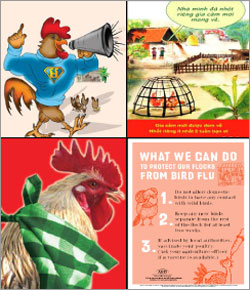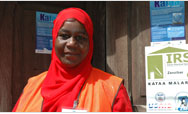Behavior Change Communications
| |
 |
|
|
|
 |
| |
Materials used in USAID's avian influenza communications activities (prepared by the Academy for Educational Development) Clockwise from top left: Cambodia's "Super Chicken," Vietnam poster, educational poster, Ghana poster image. |
|
|
|
|
|
|
Highly pathogenic avian influenza due to H5N1 avian influenza (AI) remains primarily an animal disease, and eradication of the virus needs to happen at the farm level or where humans interact with birds. Containing and stopping the spread of this virus is the only means of decreasing the opportunity for its possible evolution into the next human pandemic influenza virus. Early detection must be harmonized with rapid and intensive outbreak communications to prevent further spread, bring outbreaks under control, derail harmful rumors and misinformation, and reduce public anxiety.
To facilitate public communications as an outbreak intervention, USAID has compiled a matrix of key emergency outbreak and prevention messages that can be quickly adapted and diffused through existing USAID or country communications networks and organizations.
USAID is also employing integrated AI behavior change communications approaches to inform target audiences about the disease and introduce best practices for its prevention and containment. Such approaches include:
- Interpersonal communications that employ agriculture and veterinary extension agents, patient counseling by clinic staff, and peer educators (farmer-to-farmer, vendor-to-vendor, and vendor-to-consumer)
- Organizational and community outlets, such as workplace, schools, community- and village-level meetings, affinity groups (community groups, farmer organizations, health associations, etc.)
- Mass media, including television, radio, and print
- Public relations/advocacy, such as leader conferences, press briefings to increase the media’s understanding and access to correct and appropriate information, and training of public spokespersons
- Private sector partnerships
In addition, USAID is funding the Communications Initiative to maintain an up-to-date Web page on AI. More in-depth information, articles, links to other key Web sites, as well as examples of current communications materials, products, and key messages used in AI campaigns, can be found at www.comminit.com/avianinfluenza.html.
USAID is currently implementing behavior change communications activities for AI through the Academy for Educational Development. Information on this campaign, as well as AI materials and messages, can be found at www.aed.org/avianflu/.
Latest News and Resources
Related USAID Programs
Additional Information on Avian and Pandemic Influenza
|


